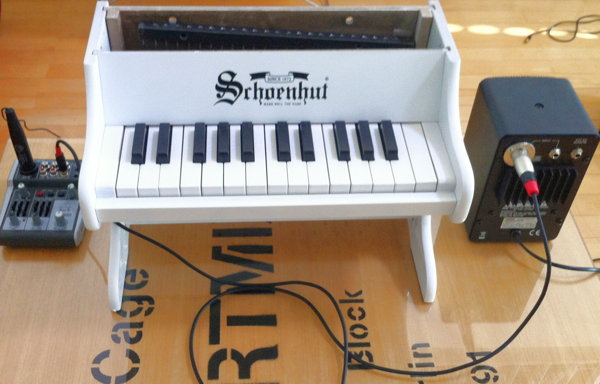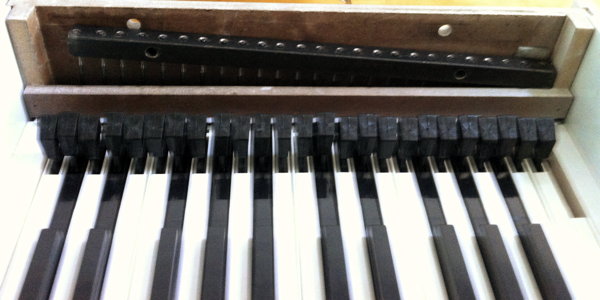Miles to go
for 4 prepared and amplified toy pianos2012
Commissioned by the Philharmonie Luxembourg for the "Toy Piano World Summit"
Basics
| Amplification | Preparation | Score | Listen | Performances
Commissioned by the Philharmonie Luxembourg for the "Toy Piano World Summit"
Basics
| Amplification | Preparation | Score | Listen | Performances
Miles to go performed by Isabel Ettenauer, Jennifer Hymer, Stefan Weinzierl,
Bernhard Fograscher (toy piano) and Daniel Moreira (conductor)
Toy Piano | Non Piano Weekend
Laeiszhalle Hamburg, 27 Sep 2014
Video: Daniel Moreira
For every new piece involving the toy piano, I have set out to convey a different perspective. This time, however, I felt stuck for ideas and didn't want to repeat myself. In my despair, I began to dismantle a 25-key table-top piano. I opened the case and removed the set of tines that are responsible for producing the characteristic chime-like sounds of the instrument. Then I changed its position so that the hammers were not hitting the rods. Instead, the metal bar to which they are mounted was struck to create a metallic noise without any pitches. To make these subtle sounds more audible, I connected a contact microphone to the sound board and amplified the signal with a small loudspeaker. I was amazed at this new sound world. A new instrument was born: a gamelan-like percussion orchestra at my fingertips! Along with those metallic tones, this modified instrument contained even more sounds: a dry wooden attack on the lowest key (where the hammer directly hits the sound board) and also a few notes that still produce the usual toy piano tones.
These new possibilities immediately kindled my imagination. By improvising with this setup, I discovered a variety of structural elements that attempted to connect to each other. Furthermore, the amplification became more and more important; not only to make the instrument louder, but also to achieve an aggressive expression more reminiscent of a thrash metal band than that of a children's instrument.
In Miles to go, the four players are treated as a single unit, forming a single meta-instrument. They are not merely playing different voices, but contributing to a common sound that they are creating together. The dense and fast hammering at independent tempos creates haunting phasing effects that appear as an aural rendering of the well-known visual moiré patterns. These hectic and breathless movements evoke moments of stress and unrest but at a certain point, become transformed by the listener to the opposite: a quality of calmness. Finally, another transformation takes place when the percussive attacks are gradually replaced by soft and flowing sounds, which are achieved by stroking and scratching the soundboard with the handle of a percussion mallet.
This formal process gave rise to the title "Miles to go" which was borrowed from the poem Stopping by Woods on a Snowy Evening by Robert Frost:
NB: It is absolutely necessary that all instruments are using exactly the same audio gear!

Amplification setup: Behringer mixer, toy piano, loudspeaker
Remove the upper lid from the tabletop toy piano. Remove the two screws that are holding the tone comb. Place it loosely into the slot and shift it to the right side of the piano. Lift the tone comb and position it on the horizontal wood strip. Secure it there with a small piece of foam rubber which is inserted between the right end of the metal bar and the resonance board. Now, the hammers of the upper octave are not hitting the metal rods but only the metal bar to which they are mounted. This will result in an unpitched, metallic sound. As the lowest key is hitting the resonance board, it will produce a wooden sound. Note that the keys between low d and low f# are striking the rods - these are the only four keys which would produce the commonly known toy piano sounds. (NB: those tones are actually sounding a half tone lower due to the shifting of the tone comb to the right side.) Finally, the two highest key produce a variant of the the aforementioned metallic sound, however damped due to the rubber foam.

Correct position of the toy piano's tone comb
Following this procedure, the toy piano will now produce the following sounds:

Miles to go performed by Isabel Ettenauer, Jennifer Hymer, Stefan Weinzierl,
Bernhard Fograscher (toy piano) and Daniel Moreira (conductor)
Toy Piano | Non Piano Weekend
Laeiszhalle Hamburg, 27 Sep 2014
The score of Miles to go can be downloaded for free. Please note that the music is protected by copyright.
| Home | Works | Sounds | Bibliography | Concerts |
Updated: 29 Nov 2021